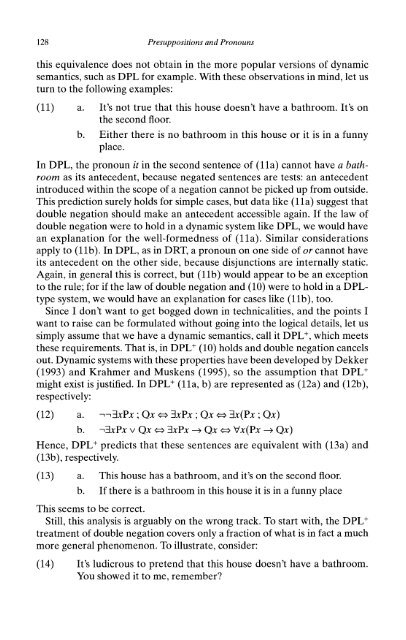Presuppositions and Pronouns - Nijmegen Centre for Semantics
Presuppositions and Pronouns - Nijmegen Centre for Semantics
Presuppositions and Pronouns - Nijmegen Centre for Semantics
You also want an ePaper? Increase the reach of your titles
YUMPU automatically turns print PDFs into web optimized ePapers that Google loves.
128 <strong>Presuppositions</strong> <strong>and</strong> <strong>Pronouns</strong><br />
this equivalence does not obtain in the more popular versions of dynamic<br />
semantics, such as DPL <strong>for</strong> example. With these observations in mind, let us<br />
turn to the following examples:<br />
(11) a. It's not true that this house doesn't have a bathroom. It's on<br />
the second floor.<br />
b. Either there is no bathroom in this house or it is in a funny<br />
place.<br />
In DPL, the pronoun it in the second sentence of (lla) cannot have a bath-<br />
bathroom<br />
as its antecedent, because negated sentences are tests: an antecedent<br />
introduced within the scope of a negation cannot be picked up from outside.<br />
This prediction surely holds <strong>for</strong> simple cases, but data like (lla) suggest that<br />
double negation should make an antecedent accessible again. If the law of<br />
double negation were to hold in a dynamic system like DPL, we would have<br />
an explanation <strong>for</strong> the well-<strong>for</strong>medness of (lla). Similar considerations<br />
apply to (llb). (lib). In DPL, as in DRT, a a pronoun on one side of or cannot have<br />
its antecedent on the other side, because disjunctions are internally static.<br />
Again, in general this is correct, but (llb) (lib) would appear to be an exception<br />
to the rule; <strong>for</strong> if the law of double negation <strong>and</strong> (10) were to hold in a DPLtype<br />
system, we would have an explanation <strong>for</strong> cases like (llb), (lib), too.<br />
DPL-<br />
Since I don't want to get bogged down in technicalities, <strong>and</strong> the points I<br />
want to raise can be <strong>for</strong>mulated without going into the logical details, let us<br />
simply assume that we have a dynamic semantics, call it DPL +, + , which meets<br />
these requirements. That is, in DPL + (10) holds <strong>and</strong> double negation cancels<br />
out. Dynamic systems with these properties have been developed by Dekker<br />
(1993) <strong>and</strong> Krahmer <strong>and</strong> Muskens (1995), so the assumption that DPL +<br />
might exist is justified. In DPL + (lla, b) are represented as (12a) <strong>and</strong> (12b),<br />
respectively:<br />
(12) a. -,-,::JxPx; -.-. 3xPx;Qx^3xPx;Qx^3x(Px;Qx)<br />
Ox ~ ::JxPx; Ox ~ ::Jx(Px; Ox)<br />
b. -,::JxPx ->3xPx v Ox QJC ~ ::JxPx 3xPx ~ -» Ox Qx ~ Vx(Px V*(P* ~ -» Ox) Q*)<br />
Hence, DPL + predicts that these sentences are equivalent with (13a) <strong>and</strong><br />
(13b), respectively.<br />
(13) a. This house has a bathroom, <strong>and</strong> it's on the second floor, floor.<br />
b. If there is a bathroom in this house it is in a funny place<br />
This seems to be correct.<br />
Still, this analysis is arguably on the wrong track. To start with, the DPL +<br />
treatment of double negation covers only a fraction of what is in fact a much<br />
more general phenomenon. To illustrate, consider:<br />
(14) It's ludicrous to pretend that this house doesn't have a bathroom.<br />
You showed it to me, remember














